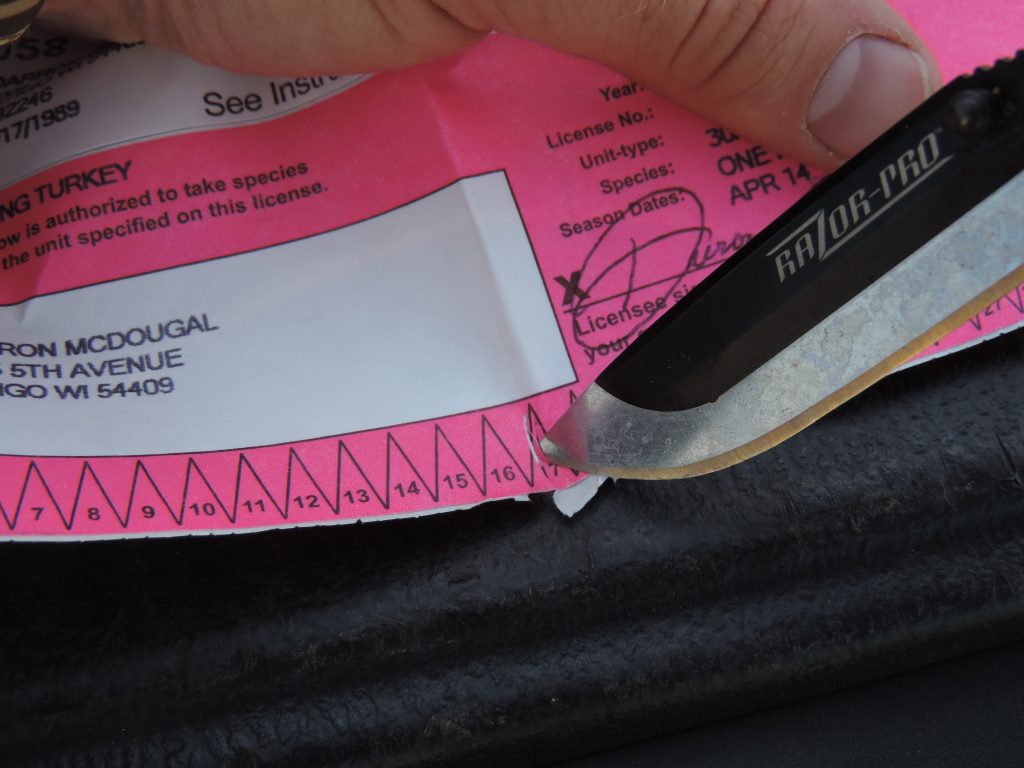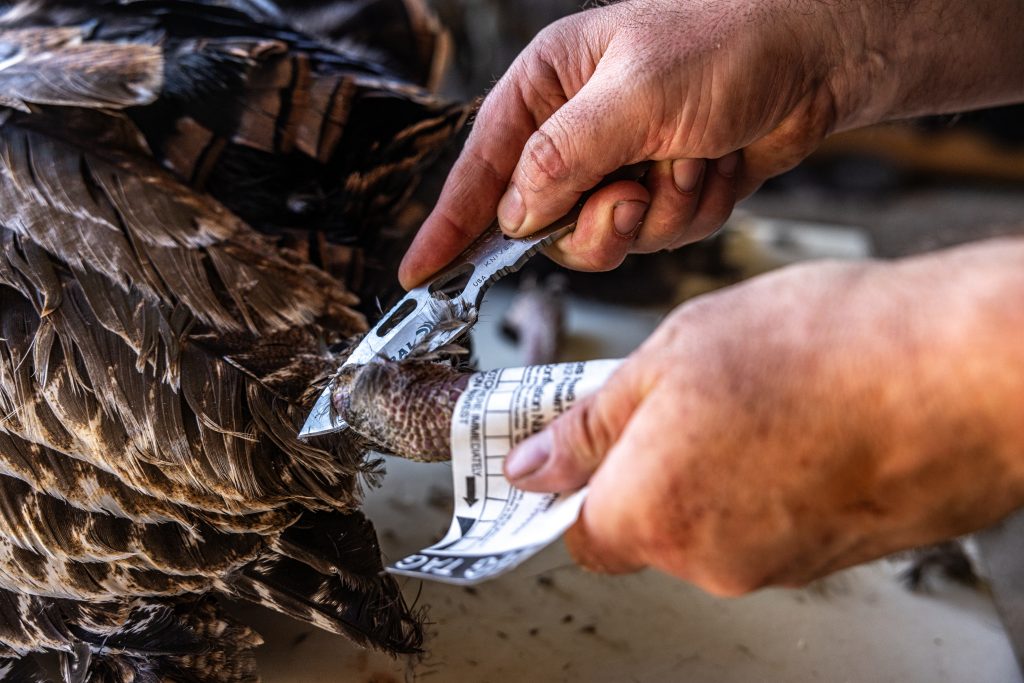The Data Behind the Harvest
A look at how some states collect harvest data and what it’s used for.
I fondly recall taking my first wild turkey ever. My brother and I were bowhunting from separate ground blinds in mid-October in a Wisconsin cornfield. Around mid-morning, a large flock decorated the field. I’ll admit that I missed two easy shots, but I pulled myself together, my third arrow connecting perfectly with a hen. I was one stoked 14-year-old bowhunter!
As we’d done with two deer that I’d previously harvested, my parents and I transported my bird to a local gas station to register it. At the time, Wisconsin required deer and turkeys to be registered at one of the state’s many physical registration stations. So, we did.
For the most part, times and processes for registering or checking game have changed. While researching for this article, I spoke with three different state wildlife agencies to discuss how they compile harvest data and the ways they use it for wild turkey management.
Harvest Data Collection and Its Uses
Again, modern times have demanded better, more efficient processes for registering game across most states. What exactly does that look like? Well, to get things started, let’s look at Montana.
“In Montana, we conduct a random post-hunt telephone survey,” said Brian Wakeling, the game management bureau chief for the Montana Fish, Wildlife and Parks. “We have information regarding who bought turkey licenses, and we call a small percentage of them and give them the opportunity to respond to a few questions. We’re able to generate some pretty accurate statistics by surveying a portion of hunters and then doing some math. We calculate a total harvest estimate, harvest-per- unit effort (amount of time that a hunter spends hunting to harvest a turkey), and an approximate turkey distribution. By the way, we believe Montana’s wild turkey population, which is dispersed across about two-thirds of the state, consists of approximately 120,000 birds.”
Nick Oakley, the wild turkey biologist for Missouri’s Department of Conservation shared that the Show Me State uses a completely different model.
“Missouri has had mandatory reporting as long as I can recall,” he said. “Previously, we had in-person check stations for a long, long time. They were very cost-ineffective to maintain, so we switched to a phone-only tele-check system. In the last decade or so, we’ve included the options of checking harvested turkeys online through the MDC website and through our app in addition to the tele-check option.”
Oakley shared that one of this model’s major advantages is instantaneous data receipt.
“The day after the season ends, I can immediately compile a quick report of things such as the top harvest counties,” he said. “As far as how the harvest data informs management decisions, it’s one of several tools that we use. The reason for that is that harvest data is a lagging index. For example, if we experience a bad hatch, we don’t expect it to impact harvest for a couple of years. As a result, we don’t react to good or poor harvest years by changing regulations. Again, harvest is just one data point out of several in the bigger picture that we consider.”
In addition to mandatory reporting, Missouri issues hunters an annual survey. It asks hunters which days they hunted during the 21-day season. From the information compiled, the MDC can calculate a harvest-per-unit effort, which Oakley said provides useful information, too.
“We’ve seen harvest decline relatively significantly since 2004,” he said. “However, we haven’t seen a big decrease in our harvest-per-unit effort. It doesn’t mean that our wild turkey population hasn’t declined; other factors show that it has declined to an extent. But, there are 20,000-30,000 fewer hunters in the field than in 2004, so extraneous factors are at play.”
Oakley also mentioned that the MDC conducts periodic banded-bird surveys, which is a good gauge for monitoring what percentage of the wild turkey population is being harvested. He explained that it is more useful information than the raw total-harvest number.
“As far as a population, we have sort of a back-of-the-envelope estimate that we use primarily internally,” Oakley shared. “I’ve also given this estimate to Turkey Call whenever the editors request it for the spring hunting outlook. We’re currently developing a more robust two-sex population model. It’s been in the works for years, but I’m optimistic that we’ll get it up and running within the next couple of years.”
Georgia’s harvest-data-collection model resembles Missouri’s to an extent. Emily Rushton, a wildlife biologist with the Georgia Department of Natural Resources, explained its workings.
“Before going hunting, turkey hunters must download and print a harvest record,” she said. “It’s free and goes on your hunting license. Hunters must log their turkey harvest before moving the bird from the kill site. Within 24 hours following the harvest, it also must be checked in via Georgia Game Check using one of three methods. It can be done on the Georgia DNR website, on the Outdoors GA app, or by calling the Game Check phone number. The app is by far the easiest way to do this. You can even check in a harvest in the app without phone service; it will automatically upload when you return to cell service.”
The harvest data the Georgia DNR collects is particularly useful for setting WMA quotas (for WMAs with quota hunts). Rushton also said that hunters are required to sign in before hunting on WMAs.
“We look at the number of hunters who’ve signed in and compare it with the number of birds harvested,” she said. “We can adjust quotas accordingly. We also use harvest data when we look at our regulations. We’ve learned that no matter when our season begins, about 60% of the overall harvest happens within the first two weeks, which is beneficial to know.”
Is It Working?
Since wild turkey numbers are diminishing in some states, an emphasis on management plays a vital role in the wild turkey’s future. In other words, mismanagement could squander a treasured resource. So, the question is, are the harvest-reporting mediums that states are using working?
“Currently, our harvest survey model here in Montana is working very well,” Wakeling said. “We haven’t had to limit the number of hunters pursuing turkeys. However, we do get some pushback from the public — especially the hunting public. Some folks feel that important information is missing when harvest reporting isn’t mandatory, and they have a persistent interest in making it mandatory.
“In Nevada, reporting is mandatory,” Wakeling said. “Hunters who fail to report their harvest face a $50 penalty or the inability to apply to hunt the following year. That yields an incredibly high reporting response rate; the last I heard, it was about 96%. The problem is that the penalty can hinder hunter recruitment and retention.

Plus, I don’t believe that the information Nevada compiles from mandatory reporting is a lot better than what we get through our random survey here in Montana. Eventually, you reach a point of diminishing returns. For example, if a third of the turkey hunters in a given state respond to a survey, you can generate very accurate figures from that data.”
As Oakley said earlier, the MDC is refining its method of estimating wild turkey populations, but he said that “harvest data is still a pretty good index of abundance, particularly when we review several years and tabulate trends.”
Rushton expressed confidence but also discussed some challenges in Georgia’s model for compiling and using harvest data.
“Our model gives us daily harvest data down to the county level, which helps us identify regional patterns using more fine-scale data than we’ve had previously,” she explained. “Although Georgia runs a tight ship with harvest reporting, we find it perpetually challenging to determine how many turkeys we have in Georgia. We do a post-hunt survey to determine how many people hunted turkeys and how many turkeys were harvested, which helps us calculate a success rate. When that success percentage drops, it’s a warning sign that the population is likely decreasing. That being said, we’ve been relying more on trends over time than hard population estimates to inform management decisions.”
Can Harvest Data Yield Accurate Population Estimates?
After chatting with Wakeling, Oakley, and Rushton, I looped in Dr. Michael J. Chamberlain, National Wild Turkey Federation Distinguished Professor at the University of Georgia. I wanted to know if he believes that population estimates can be more accurately calculated in order to better inform wild turkey management.
“Ideally, all states would collect at least some basic information from turkey hunters, such as hunter effort,” Chamberlain began. “Knowing hunter effort would allow agencies to improve their understanding of trends in harvest both within and across states. Recently, many states have changed how they collect harvest data, such as mandatory reporting of kills and standardizing how they collect data, which improves harvest data. I think agencies will continue to tweak their procedures as they recognize the importance and value of having better datasets from which to make decisions.”
Does harvest data help state agencies calculate accurate population estimates? Chamberlain believes that to be a loaded question.
“The bottom line is no,” he said. “Harvest is mostly a metric that follows trends in hunter effort — the more effort, the more harvest, at least up to a point. Inferring population abundance solely from harvest data is fraught with potential biases because we know that harvest is impacted by many factors, particularly hunter effort.”
Going Forward
Just like registration and check-in processes have improved, a constant effort is being made to develop better processes and metrics for monitoring and managing the wild turkey. In the latest round of wild turkey research projects the NWTF helped fund in 2024, at least two (Florida and Texas) have studies involving wild turkey population dynamics.
“Being able to accurately estimate wild turkey population sizes is something that has been sorely lacking for many decades and has been discussed as an important research need since the days prior to restoration,” Chamberlain said. “The reality is that estimating population sizes accurately isn’t an easy task, and our ability to do so differs across landscapes. There is ongoing research trying to determine various ways of getting abundance estimates. Hopefully, those efforts will provide us with better ways to determine what harvest numbers make the most sense biologically.”

Percentage of Check-Ins by Method
As an example, below are the percentages of method used to report a harvest in Missouri in 2024.
76% MO Hunting App
17% Tele-check
8% MDC Website
